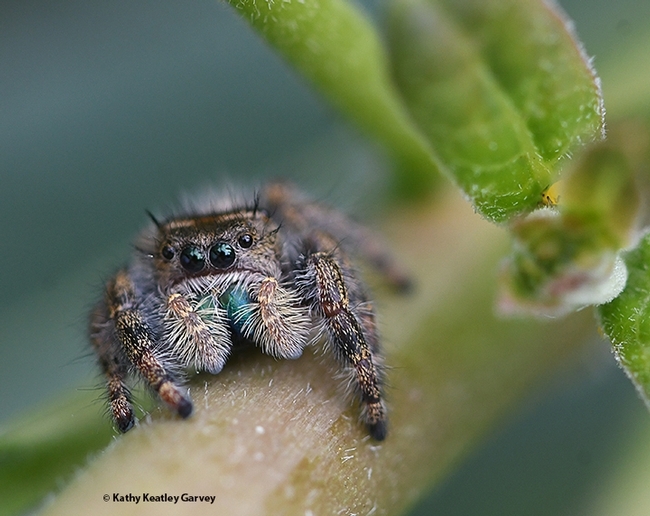- Author: Kathy Keatley Garvey
It's Arachtober and that means celebrating arachnids for the entire month of October.
Well, we ought to celebrate them year around, but October is THEIR month.
Let's especially applaud crab spiders when they prey on such agricultural pests as the lygus bug, also known as the "western tarnished plant bug." It's a member of the genus Lygus in the family Miridae and feeds on plants by piercing the plant tissues.
The lygus bug is easily distinguished by the triangular mark on its back.
The western tarnished plant bug (Lygus hesperus) is known as a very serious pest of cotton, strawberries and seed crops such as alfalfa, entomologists tell us. In California alone, the bug causes $30 million in damage to cotton plants each year, "and at least $40 million in losses to the state's strawberry industry," according to Wikipedia.
"Lygus bugs are one of the causes of irregularly shaped, cat-faced strawberries; another cause may be poor pollination, which results in small undeveloped seeds," says UC Statewide Integrated Pest Management Program (UC IPM) in its Pest Management Guidelines. "Lygus bugs damage fruit by puncturing individual seeds; this, in turn, stops development of the berry in the area surrounding the feeding site. Straw-colored seeds that are large and hollow are a good indication of lygus bug damage. Lygus bug damage is more of a problem in strawberry-growing areas where continuous fruit production occurs.
"Adults are about 0.25 inch (6 mm) long, oval, and rather flattened," UC IPM points out. "They are greenish or brownish and have reddish-brown markings on their wings."
So what happens when a crab spider nails a lygus bug?
The cheering section is loud.

- Author: Kathy Keatley Garvey
It's October and Arachtober: the month to celebrate spiders and other arachnids.
As arachnologists will tell you, arachnids are arthropods that include spiders, scorpions, ticks, mites, pseudoscorpions, harvestmen, camel spiders, whip spiders and vinegaroons.
Arachnids need love, too, especially in October when spiders compete with ghosts, goblins and ghouls for your attention.
Meanwhile, scientists and arachnid fans are posting their favorite eight-legged images on their websites and social media.
Even Flickr celebrates Arachtober via a photography pool formed in September 2008. "The pool is open! Thanks everyone for participating, spreading the spider love, and making this fun!...This group is similar to a 365 group, the goal is to post spiders to Flickr daily during October. When you shot them is less important...Post what you have. You can either post them daily till you run out, spread them out every few days, or save them till Halloween week for Spider Blitz. Spiders are especially popular around then."
His five good reasons to love spiders?
- Spiders consume 400-800 million tons of prey, mostly insects, each year. Humans consume somewhere around 400 million tons of meat and fish each year.
- Spider silk is one of the strongest naturally occurring materials. Spider silk is stronger than steel, stronger and more stretchy than Kevlar; a pencil thick strand of spider silk could be used to stop a Boeing 747 in flight.
- Some spiders are incredibly fast – able to run up to 70 body lengths per second (10X faster than Usain Bolt).
- Although nearly all 47,000-plus spider species have venom used to kill their insect prey, very few actually have venom that is harmful to humans.
- Some spiders are really good parents –wolf spider moms carry their young on their backs until they are ready to strike out on their own; female trapdoor spiders keep their broods safe inside their burrows often longer than one year, and some female jumping spiders even nurse their spiderlings with a protein rich substance comparable to milk.
Happy Arachtober! Here are three jumping spiders that you can love, or try to love....Then on March 14 you celebrate Save a Spider Day.





